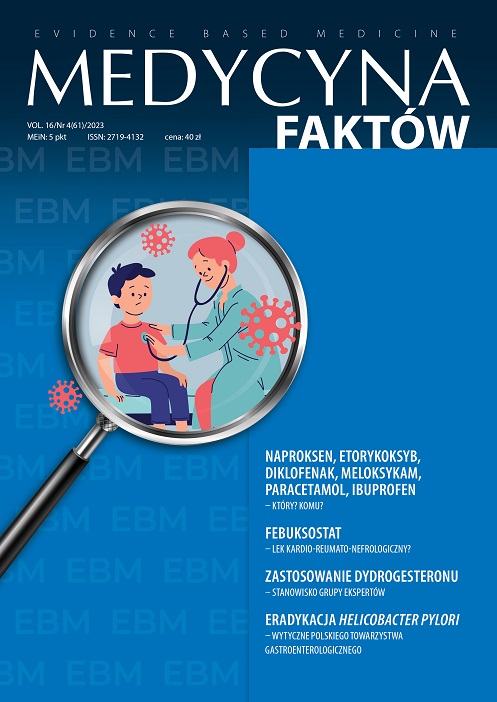Skuteczne leczenie bólu i gorączki u dzieci – opisy przypadków Opis przypadku
##plugins.themes.bootstrap3.article.main##
Abstrakt
Ból i gorączka to najczęstsze powody zgłaszania się rodziców z dziećmi do pediatry. Gorączka to nienormalny wzrost temperatury ciała występujący jako część specyficznej odpowiedzi biologicznej na chorobę. Ból i gorączkę leczymy u wszystkich dzieci, u których prawidłowo je zidentyfikowaliśmy i zinterpretowaliśmy, a nasze działanie ma przede wszystkim zmniejszyć dyskomfort i niepokój u pacjenta. Podstawowymi lekami w leczeniu bólu i łagodzeniu gorączki są paracetamol i ibuprofen (jako niesteroidowy lek przeciwzapalny), a ich skuteczność została potwierdzona w wielu badaniach klinicznych. W przypadku, gdy monoterapia w optymalnych dawkach nie powoduje skutecznego zmniejszenia bólu i gorączki, warto zastosować leczenie skojarzone (ibuprofen + paracetamol w jednym preparacie).
##plugins.themes.bootstrap3.article.details##
Copyright © by Medical Education. All rights reserved.
Bibliografia
2. Amaechi O, Huffman MM, Featherstone K. Pharmacologic Therapy for Acute Pain. Am Fam Physician. 2021; 104(1): 63-72.
3. Doniec Z, Jackowska T, Sybilski A et al. FEVER in children – recommendations for primary care doctors – FEVER COMPASS. Fam Med Prim Care Rev. 2021; 23: 99-115.
4. Sahib El-Radhi A, Carroll J, Klein N et al. Measurement of Body Temperature. In: Sahib El-Radhi A, Carroll J, Klein N (ed). Clinical Manual of Fever in Children. Springer, Cham, Switzerland 2018: 69-84.
5. Woroń J. Farmakoterapia gorączki. Farmakologia leków przeciwgorączkowych. In: Sybilski AJ, Woroń J, Życińska K (ed). Gorączka. Przyczyny, diagnostyka, leczenie. Medical Education, Warszawa 2021: 67-78.
6. NICE Guideline Updates Team (UK). Fever in under 5s: assessment and initial management. London: National Institute for Health and Care Excellence (UK); 2019 Nov. (NICE Guideline, No. 143).
7. Dipiro JT, Talbert RL, Mee GC et al. Pharmacotherapy: A Pathophysiologic Approach, 10e. McGraw Hill, New York 2020.
8. Martindale. The Complete Drug Reference. Pharmaceutical Press, London 2020.
9. Paul IM, Walson PD. Acetaminophen and ibuprofen in the treatment of pediatric fever: a narrative review. Curr Med Res Opin. 2021; 37(8): 1363-75.
10. Muśko M, Sznitowska M. Postacie leków pediatrycznych. Część I. Wymagania i podstawowe problemy – dawkowanie, połykanie, smak. Farm Pol. 2010; 66(3): 215-20.
11. Hryniewicz W, Albrecht P, Radzikowski A (ed). Rekomendacje postępowania w pozaszpitalnych zakażeniach układu oddechowego. Narodowy Instytut Leków, Warszawa 2016.
12. Pokorna-Kałwak D, Jazienicka-Kiełb A. Ear infections in children. Supportive treatment with antibiotic therapy. Lekarz POZ. 2023; 9(1): 43-9.
13. Luo S, Ran M, Luo Q et al. Alternating Acetaminophen and Ibuprofen versus Monotherapies in Improvements of Distress and Reducing Refractory Fever in Febrile Children: A Randomized Controlled Trial. Paediatr Drugs. 2017; 19(5): 479-86.
14. Charde V, Sanklecha M, Rajan P et al. Comparing the Efficacy of Paracetamol, Ibuprofen, and a Combination of the Two Drugs in Relieving Pain and Fever in the Pediatric Age Group: A Prospective Observational Study. Cureus. 2023; 15(10): e46907.
15. Parri N, Silvagni D, Chiarugi A et al. Paracetamol and ibuprofen combination for the management of acute mild-to-moderate pain in children: expert consensus using the Nominal Group Technique (NGT). Ital J Pediatr. 2023; 49(1): 36.
